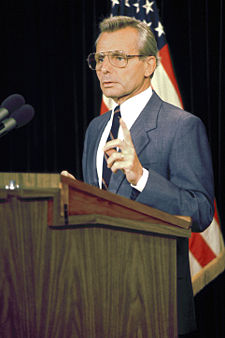South Yemen 1980-82

Deputy CIA director Frank Carlucci
Two U.S. presidents pursued a policy of punctuated military operations against South Yeman. Upon becoming independent from the United Kingdom , the regime in Aden had moved to the left and, by the late 1970s, was said to have Soviet and Cuban advisers; as a result, U.S. policy makers were convinced South Yemen posed a threat to Saudi Arabia , particularly in light of the Cuban presence in Ethiopia . Since 1970, the Saudis had been aiding North Yemen to fight a covert war against South Yemen , an effort in which the British also participated. With the fall of the Shah in Iran , officials in Washington decided to bolster the Saudis by letting them buy tanks and fighter jets for North Yemen (the plan was that the Saudis would also buy U.S. weapons for Sudan ). Less than two weeks later, fighting broke out between the two Yemens, and the U.S. responded by increasing the size of its arms package for the North and rushing a portion of it there, along with military advisers who would train the Yemenis in their use; sending an aircraft carrier task force and surveillance planes to the region; and offering U.S. fighter jets to Saudi Arabia to permit the Saudis to use their own air power in North Yemen. Predictably, several of these actions were only undertaken after the two Yemens had moved toward a ceasefire.
Carter's defensive moves only partly allayed Saudi concerns, and the two governments began discussing ways of increasing the size and deadliness of the existing Saudi-backed North Yemeni raids into the South. Eventually, Carter agreed to a plan that involved training South Yemeni exiles in Saudi Arabia and inserting them back into their country. This program was continued when Reagan took office, and ended up with the same kind of dismal results as had the earliest such programs in Eastern Europe (see chapter six of the book): one group of raiders was captured, tortured, and made to confess CIA involvement; another group was then quietly withdrawn. It does not appear that the pipeline contained any other exiles, and after the operation was blown, the Saudis and other U.S.-siding regimes in the region began to make their peace with Aden . By then, North Yemen had already begun flirting with the Soviet Union ; and eventually, the North merged with the South into a common state.1
1) “Yemen, Sudan to Get Added Arms,” New York Times , 12 February 1979; also other articles, 27 February, 6, 8, 13, 20, 29 March, 1 April 1979, 6 February 1980; “Carlucci Launched CIA Operation in Yemen That Collapsed,” Washington Post , 4 December 1986; Brzezinski (1983: 178, 447); Woodward (1987: 78, 215); Gates (1996: 149-50); Gasiorowski (2004: 688).
